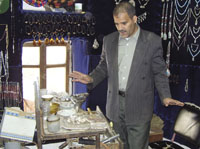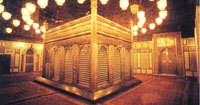
Onyx: The Yemeni agate [Archives:2007/1016/Culture]
January 15 2007
 |
 |
Onyx, a translucent cryptocrystalline variety of quartz, is one of nature's most beautiful gemstones. For thousands of years, man has prized onyx for personal adornment because this variegated onyx is characterized by oft-contrasting colors that may be arranged in strongly contrasting bands, irregular swathes of color or moss-like inclusions.
Onyx is known for its qualities in terms of brightness and translucency. The level of darkness in color is equal at all its parts as well as its hardness. “Onyx is very hard on all sides and that's what makes it excel,” said professor Mohammed Heikal.
The existence of volcanic rock in Yemeni mountains, particularly in Anis in Dhamar, “gives the onyx a suitable environment to be formed. The melting process of silicon dioxide (or SiO2) takes place in the hollows of the rocks and consequently precipitates to form onyx in heat not less than 20 degrees (less than the geothermal of 20 degrees),” says Dr. Saif Ali Othman of the Earth Environmental Sciences department.
“According to the visible impurities in the body of the onyx these are seen in dendritic shapes and colors such as rose, smoky gray or white,” adds Mounir Ismail, assistant professor at the Earth Environmental Sciences Department. The colors and patterns of onyx imitate forms in nature, such as trees, animals, people, birds and mountains, or particular words like the names of Allah and Mohammed (pbuh) in Arabic. In some rare cases, the Kaaba and the Yemeni flag form.
“We mine the agates from the mountains, and break them down to remove dirt and blemishes. We try to observe the natural pattern created inside the onyx, cut the blemish, and sharpen it until it takes a lucid design,” stated Ibrahim Sharhan, general manager of Yemen Onyx Kingdom Industries.
“The first step is tajmeer (broiling), which is used depending on the onyx's size and kind. Some agates are too hard to cut and require additional heating time lasting up to 30 days. Stones are placed in a specialized fireplace within an iron vessel using temperatures between 250 and 300 degrees Fahrenheit. Tajmeer decreases the agate's hardness, making them pliable while adding glitter.
“Next is tarmeel, where stones are put side by side in a burner covered in two-inch thick ash (approximately two fingers deep).The stones are pressed to avoid ventilation under equally distributed coals. This process lasts up to six day because it helps distribute color into all sections of the agate. During this process, it's better to put the broken side of the stones on the outer edges so the heat affects them directly. The agates are cut into several sizes and the Jalkh machine is used to sharpen and make the patterns within more lucid.
“The final step is to polish the stones with the Dabasha machine, which resembles a plastic jar. It shakes the stones in a special powder for seven to 12 days until they're lustrous and smooth. We can't use the machine unless we have 500 to 1,000 stones,” jeweler Mohammed Ali explained. “However, handmade purifications are better. We use sandpaper spinning around a fixed point on the machine holding the stones to the sandpaper for 15 minutes. We use this method if we have less than 500 stones,” Ali added.
Types of onyx
Onyx is used in jewelry; especially as inlays in rings, necklaces, medals and rosaries, and used to decorate dresses, daggers and swathe. Stones come in a variety of colors and shades of red, black, blue, white, yellow and in patterns such as Solymani and dendrites. Amazingly, no two onyxes are the same. One of the most famous is Al-Rumani named after the color of pomegranate seeds.
Today, onyx remains very much in demand because it's a uniquely patterned gem offering its owners beauty and durability. However, natural onyx is scarce nowadays. Still considered the best for its natural brilliance, color and clarity, Yemeni agate defies those stones manufactured with lasers in neighboring Gulf countries.
——
[archive-e:1016-v:14-y:2007-d:2007-01-15-p:culture]


